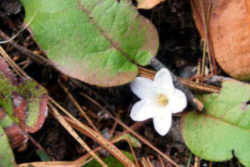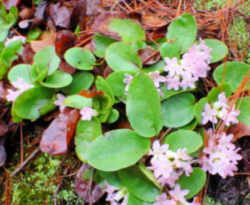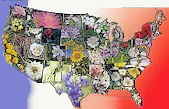
Massachusetts Symbols
Massachusetts State Flower of Floral Emblem
Mayflower (trailing arbutus)

(Epigaea repens)
Adopted on May 1, 1918
The Mayflower, (Epigaea regens,) also commonly known as the ground laurel or trailing arbutus, was adopted as the official flower of the Commonwealth by the General Court on May 1, 1918. Unfortunately, since May 17, 1925 it has been on the endangered list.
The Mayflower has ovate hairy leaves and fragrant, pink or white, spring-blooming flowers with five petals. It grows in woods, preferring sandy or rocky soil, under or near evergreens.
The mayflower, or trailing arbutus,
was favored for adoption as Massachusetts' state flower at least as early as 1893. Two previous bills were introduced and defeated prior to 1918, when
Representative Myles A. O'Brien, Jr. introduced the third mayflower bill. Consequently another bill was introduced to designate the water lily. Other
flowers were then also proposed.
With this turn of events, the Department of Agriculture given the responsibility for selecting the state flower. Unwilling to do, they passed it on
the State Board of Education.
So, Massachusetts school children were given the chance to vote for their favorite state flower. The mayflower won with 107,617 votes, and the water
lily was second with 49,499 votes.
It was adopted as the official flower of the Commonwealth by the General Court on May 1, 1918. Unfortunately, since 1925 it has been on the endangered list.
Mayflower - Named by the Pilgrims "who saw in the rise of the new leaves over the brown of last year's foliage a parallel to their own rise over great hardship." (Hussey, 1974).
Massachusetts State Flower or Floral Emblem:
Mayflower

Epigaea repens - known as mayflower or trailing arbutus - is a low, spreading shrub in the Ericaceae family. It is found from Newfoundland to Florida, west to Kentucky and the Northwest Territories.
The species flowers are pink, fading to nearly white, very fragrant, about .5 inches (1.3 cm) across when expanded, few or many in clusters at ends
of branches. Calyx of 5 dry overlapping sepals; corolla salver-shaped, the slender, hairy tube spreading into 5 equal lobes; 10 stamens; 1 pistil with
a column-like style and a 5-lobed stigma. Stem: Spreading over the ground (Epigaea = on the earth); woody, the leafy twigs covered with rusty hairs.
Leaves: Alternate, oval, rounded at the base, smooth above, more or less hairy below, evergreen, weather-worn, on short, rusty, hairy petioles.
Slow growing, it prefers moist, acidic (humus-rich) soil, and shade. It is often part of the heath complex in an oak-heath forest.
Epigaea repens is the floral emblem of both Nova Scotia and Massachusetts.
Identification of the Mayflower
- Other common names: Gravel plant, Mayflower, shadflower, ground laurel, mountain pink, winter pink.
- Description: This plant, generally referred to in the drug trade as gravel plant but more popularly known as ''trailing-arbutus" spreads on the ground with stem 6 feet or more in length. It's native, perennial, evergreen, hemicryptophyte, subshrubs, autotrophic, monoclinous, with adventitious roots and with fibrous roots, 0.02-0.4 m tall, with rhizomes.
- Flowers: The flower clusters, which appear from March to May, consist of fragrant, delicate, shell pink, waxy blossoms. They formed on short shoots, monomorphic, with sepals and petals readily distinguishable from one another, unisexual, flowers red or white or light red, 0.6-1.4 mm long, 3-5 flowers per inflorescence.
- Leaves: It has rust-colored, hairy twigs bearing leathery, evergreen leaves from 1 to 3 inches long and about half as wide. Alternate, 1 per node, spaced evenly along stem; petiolate, petiole 0.4-3(-5) cm long, hairs short and unbranched, erect.
- Fruits: Purple, about the size of a large pea. Fruits ripen four to six weeks after pollination. When ripe, the fruit splits open and ejects most of the seeds, which are embedded in a sweet, sticky pulp. Ants gather the nutritious pulp and carry it back to their nest. The ants eat the pulp but discard the seeds in their underground chambers, which provide ideal conditions for the seeds to germinate and grow. This is a classic example of mutualism, in which both the ants and the trailing arbutus benefit from each other's actions.
- Habitat and range: Trailing- arbutus spread out on the ground in sandy soil, being found from Newfoundland to Michigan and Saskatchewan and south to Kentucky and Florida.
- Part used: The leaves, gathered at flowering time.
The General Laws of Massachusetts
The law designating the mayflower as the official Massachusetts state flower or floral emblem is found in the General Laws of Massachusetts, Part 1, Title 1, Chapter 2, Section 7.
PART I. ADMINISTRATION OF THE GOVERNMENT.
TITLE I. JURISDICTION AND EMBLEMS OF THE COMMONWEALTH, THE GENERAL COURT, STATUTES AND PUBLIC DOCUMENTS.
CHAPTER 2. ARMS, GREAT SEAL AND OTHER EMBLEMS OF THE COMMONWEALTH.
SECTION 7.
Chapter 2: Section 7 Flower or floral emblem of commonwealth; protection; penalty
Section 7. The mayflower (epigaea repens) shall be the flower or floral emblem of the commonwealth. Any person who pulls up or digs up the plant
of the mayflower or any part thereof, or injures such plant or any part thereof except in so far as is reasonably necessary in procuring the flower
therefrom, within the limits of any state highway or any other public way or place, or upon the land of another person without written authority from
him, shall be punished by a fine of not more than fifty dollars; but if a person does any of the aforesaid acts while in disguise or secretly in the
nighttime he shall be punished by a fine of not more than one hundred dollars. The provisions of this section shall be enforced by all officers in
the division of law enforcement in the department of fisheries, wildlife and environmental law enforcement.
Taxonomic Hierarchy: Mayflower
Kingdom: Plantae - Plants
Subkingdom: Tracheobionta - Vascular plants
Superdivision: Spermatophyta - Seed plants
Division: Magnoliophyta - Flowering plants
Class: Magnoliopsida - Dicotyledons
Subclass: Dilleniidae
Order: Ericales
Family: Ericaceae - Heath family
Genus: Epigaea L. - trailing arbutus
Species: Epigaea repens L. - trailing arbutus
State Floral Emblems







